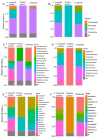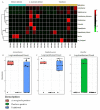Tick-Borne Pathogens Shape the Native Microbiome Within Tick Vectors
- PMID: 32854447
- PMCID: PMC7563471
- DOI: 10.3390/microorganisms8091299
Tick-Borne Pathogens Shape the Native Microbiome Within Tick Vectors
Abstract
Ticks are blood-feeding arthropods and transmit a variety of medically important viral, bacterial, protozoan pathogens to animals and humans. Ticks also harbor a diverse community of microbes linked to their biological processes, such as hematophagy, and hence affect vector competence. The interactions between bacterial and/or protozoan pathogens and the tick microbiome is a black-box, and therefore we tested the hypothesis that the presence of a protozoan or bacterial pathogen will alter the microbial composition within a tick. Hence, this study was designed to define the microbial composition of two tick species, Hyalomma (H.) anatolicum and Rhipicephalus (R.) microplus. We used a combination of PCR based pathogen (Anaplasma marginale and Theileria species) and symbiont (Wolbachia species) identification followed by metagenomic sequencing and comparison of the microbial communities in PCR positive and negative ticks. A total of 1786 operational taxonomic units was identified representing 25 phyla, 50 classes, and 342 genera. The phylum Proteobacteria, Firmicutes, Actinobacteriota, and Bacteroidota were the most represented bacteria group. Alpha and beta diversity were not significantly affected in the presence or absence of Theileria sp. and A. marginale as see with H. anatolicum ticks. Interestingly, bacterial communities were significantly reduced in Theileria sp. infected R. microplus ticks, while also exhibiting a significant reduction in microbial richness and evenness. Putting these observations together, we referred to the effect the presence of Theileria sp. has on R. microplus a "pathogen-induced dysbiosis". We also identify the presence of Plasmodium falciparum, the causative agent of human malaria from the microbiome of both H. anatolicum and R. microplus ticks. These findings support the presence of a "pathogen-induced dysbiosis" within the tick and further validation experiments are required to investigate how they are important in the vector competence of ticks. Understanding the mechanism of "pathogen-induced dysbiosis" on tick microbial composition may aid the discovery of intervention strategies for the control of emerging tick-borne infections.
Keywords: Anaplasma marginale; Francisella; Hyalomma anatolicum; Pakistan; Rhipicephalus microplus; Theileria sp.; Wolbachia; microbiome; ticks.
Conflict of interest statement
The authors declare that they have no competing interests.
Figures






Similar articles
-
A comparative study of the microbiomes of the ticks Rhipicephalus microplus and Hyalomma anatolicum.Parasite. 2024;31:74. doi: 10.1051/parasite/2024074. Epub 2024 Nov 28. Parasite. 2024. PMID: 39607975 Free PMC article.
-
Molecular and next-generation sequencing analysis of tick-borne pathogens of Rhipicephalus ticks (Acari: Ixodidae) in cattle and dogs.Acta Trop. 2024 Apr;252:107138. doi: 10.1016/j.actatropica.2024.107138. Epub 2024 Feb 1. Acta Trop. 2024. PMID: 38307363
-
A study of ticks and tick-borne livestock pathogens in Pakistan.PLoS Negl Trop Dis. 2017 Jun 26;11(6):e0005681. doi: 10.1371/journal.pntd.0005681. eCollection 2017 Jun. PLoS Negl Trop Dis. 2017. PMID: 28650978 Free PMC article.
-
The Symbiotic Continuum Within Ticks: Opportunities for Disease Control.Front Microbiol. 2022 Mar 17;13:854803. doi: 10.3389/fmicb.2022.854803. eCollection 2022. Front Microbiol. 2022. PMID: 35369485 Free PMC article. Review.
-
The Tick Microbiome: Why Non-pathogenic Microorganisms Matter in Tick Biology and Pathogen Transmission.Front Cell Infect Microbiol. 2017 Jun 8;7:236. doi: 10.3389/fcimb.2017.00236. eCollection 2017. Front Cell Infect Microbiol. 2017. PMID: 28642842 Free PMC article. Review.
Cited by
-
Dissecting the impact of Anaplasma phagocytophilum infection on functional networks and community stability of the tick microbiome.Int Microbiol. 2024 Aug;27(4):1205-1218. doi: 10.1007/s10123-023-00473-8. Epub 2023 Dec 28. Int Microbiol. 2024. PMID: 38151633
-
Recently Evolved Francisella-Like Endosymbiont Outcompetes an Ancient and Evolutionarily Associated Coxiella-Like Endosymbiont in the Lone Star Tick (Amblyomma americanum) Linked to the Alpha-Gal Syndrome.Front Cell Infect Microbiol. 2022 Apr 12;12:787209. doi: 10.3389/fcimb.2022.787209. eCollection 2022. Front Cell Infect Microbiol. 2022. PMID: 35493735 Free PMC article.
-
Analysis of the bacterial community in female Rhipicephalus microplus ticks from selected provinces in Luzon, Philippines, using next-generation sequencing.Exp Appl Acarol. 2023 Nov;91(3):463-475. doi: 10.1007/s10493-023-00851-x. Epub 2023 Oct 12. Exp Appl Acarol. 2023. PMID: 37823957
-
Feeding on a Bartonella henselae Infected Host Triggers Temporary Changes in the Ctenocephalides felis Microbiome.Pathogens. 2023 Feb 22;12(3):366. doi: 10.3390/pathogens12030366. Pathogens. 2023. PMID: 36986288 Free PMC article.
-
Tick transmission of Borrelia burgdorferi to the murine host is not influenced by environmentally acquired midgut microbiota.Microbiome. 2022 Oct 17;10(1):173. doi: 10.1186/s40168-022-01378-w. Microbiome. 2022. PMID: 36253842 Free PMC article.
References
-
- Ministry of Finance, Government of Pakistan. [(accessed on 11 July 2020)]; Available online: http://www.finance.gov.pk/survey_1819.html.
-
- Hoogstraal H., Varma M.G.R. Haemaphysalis cornupunctata sp. n. and H. kashmirensis sp. n. from Kashmir, with Notes on H. sundrai Sharif and H. sewelli Sharif of India and Pakistan (Ixodoidea, Ixodidae) J. Parasitol. 1962;48:185. doi: 10.2307/3275561. - DOI
-
- Zeb J., Szekeres S., Takács N., Kontschán J., Shams S., Ayaz S., Hornok S. Genetic diversity, piroplasms and trypanosomes in Rhipicephalus microplus and Hyalomma anatolicum collected from cattle in northern Pakistan. Exp. Appl. Acarol. 2019;79:233–243. doi: 10.1007/s10493-019-00418-9. - DOI - PubMed
Grants and funding
LinkOut - more resources
Full Text Sources

